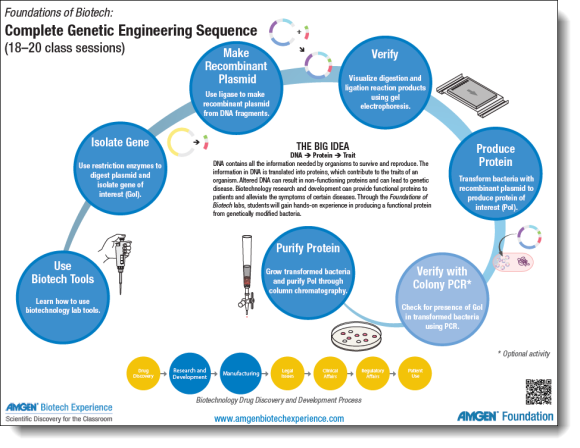
The Foundations of Biotech labs were created to introduce students to biotech techniques and concepts; in these labs, students explore recombinant DNA technology.
Sequences of these labs were designed to give options to teachers based on their available time and resources. Sequence options are listed below.
FULL PACKAGE OF MATERIALS
View the entire Foundations of Biotech package of materials (all of the below sequences are included):
- Teacher Guide [7 MB] (password protected) | La Guía del profesor—todas secuencias (protección por contraseña)
- Student Guide [6 MB] | La Guía del estudiante—todas secuencias
Graphic of the Foundations of Biotech lab sequences: Downloadable PDF | Interactive

Related Resources
MiniPrep Documents
- Overnight Culture: Preparing an Overnight Culture of E. coli for Plasmid Miniprep
- Plasmid Purification: Purification of pARA-R from an Overnight Culture
- Plasmid Confirmation: Restriction Analysis of Purified pARA-R
- Electrophoresis Systems Guidelines
SEQUENCE OPTIONS
Complete Genetic Engineering Sequence (18–20 class sessions)
In the Complete Genetic Engineering Sequence, students explore how to use recombinant DNA techniques to introduce new genes into an organism and have that organism produce new proteins. In this sequence, students create a recombinant plasmid with a red fluorescent protein gene from a sea anemone. They then transform Escherichia coli (E. coli) with the plasmid. The process is analogous to the process used to produce human therapeutic protein proteins, such as insulin or human growth hormone.
- Teacher Guide (password protected)
- Student Guide
Related Resources
- List of Laboratory Reagents
- Complete Genetic Engineering Pathway PowerPoint
- Big Idea Graphic for the Complete Genetic Engineering Sequence (PDF)
Abridged Genetic Engineering Sequence (16–18 class sessions)
The Abridged Genetic Engineering Sequence is identical to the Complete Genetic Engineering Sequence except that students are provided with the recombinant plasmid rather than creating it themselves.
- Teacher Guide (password protected) | Guia do professor - Versão Internacional (protegido por senha)
- Student Guide | Guia do estudante
Related Resources
- List of Laboratory Reagents
- Abridged Genetic Engineering Pathway PowerPoint
- Big Idea Graphic for the Abridged Genetic Engineering Sequence (PDF)
Focus on Bacteria Sequence (12–14 class sessions)
The Focus on Bacteria Sequence allows students to complete the process of bacterial transformation. In this sequence, students are provided with the plasmid that they use to transform the bacteria and do not complete the confirmation steps.
- Teacher Guide (password protected)
- Student Guide
Related Resource
Introduction to Biotechnology Sequence (4–5 class sessions)
In the Introduction to Biotechnology Sequence, students read about the genetic engineering process and learn how to use basic biotechnology lab tools. By completing this sequence, students learn that specific tools are used in recombinant DNA techniques.
- Teacher Guide (password protected)
- Student Guide
Related Resource
Extension: Colony PCR (1–2 class sessions)
In this extension lab, students sample a colony from one of their plates and perform PCR on it to confirm the presence of the desired plasmid.
- Teacher Guide (password protected) | Guía para el profesor (protección por contraseña)
- Student Guide | Guía para el estudiante
Extension: Gel Electrophoresis Troubleshooting (3 class sessions)
In Foundations of Biotech, students use gel electrophoresis to verify ligation and proper insertion of a gene into a plasmid. However, some students have problems with their gels when using GelGreen: the larger DNA bands exhibit inconsistent migration through the gel. In this extension lab, students develop their own experiments to explore why this inconsistent DNA migration happens and what can be done to correct it.
- Teacher Guide (password protected)
- Student Guide
| Class sessions |
4–20
|
|---|---|
| Resource Type |
Teaching Materials
Lab-based
|
| Appropriate Ages |
Upper Secondary
Advanced
|
| Resource Topic |
Biotech & Medicine
Human Disease
Pharmaceuticals
Biotech & Society
Race & Genetics
Bioethics
Lab Safety
Lab Techniques
Cloning
Column Chromatography
Gel Electrophoresis
Gene Editing
Gene Sequencing
Ligation
PCR
Pipetting
Plating
Restriction Enzyme
Transformation
Teaching and Learning
Workforce Preparation
|